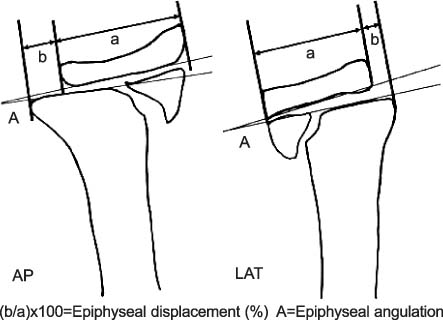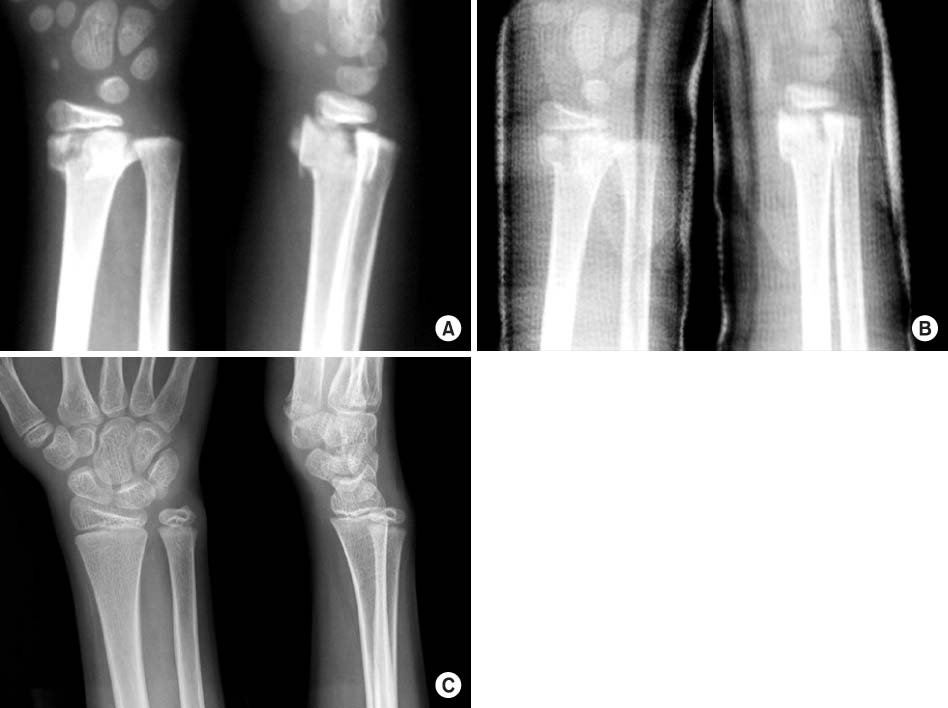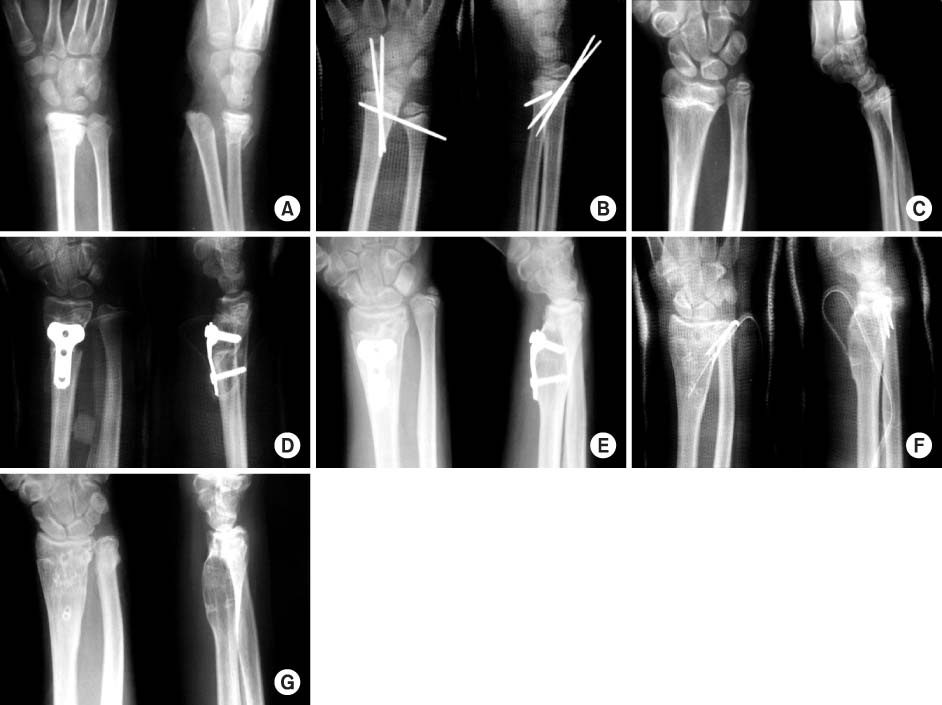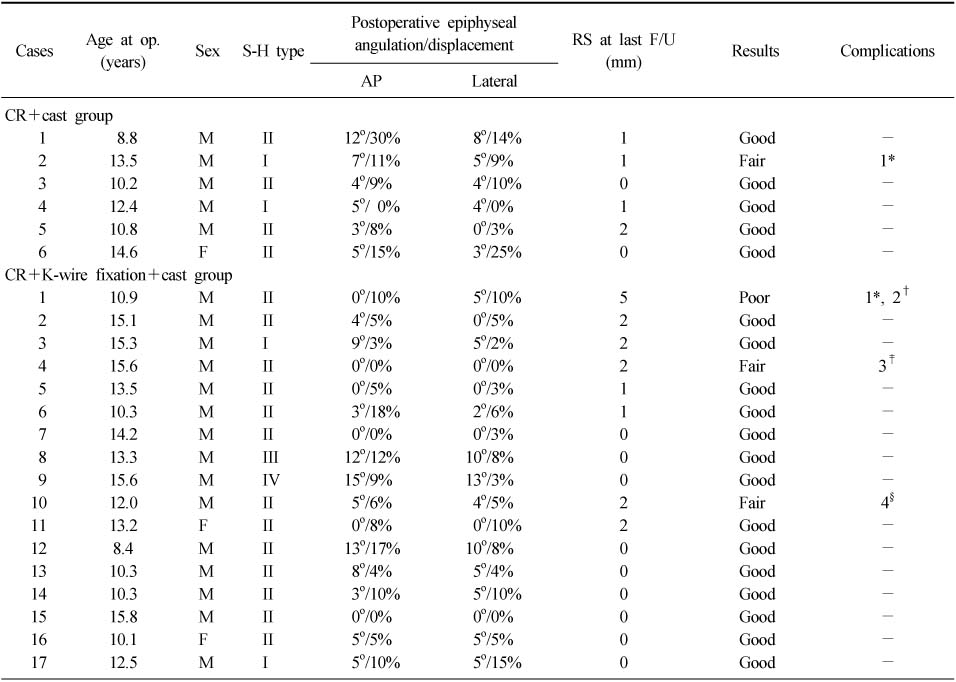Articles
- Page Path
- HOME > J Musculoskelet Trauma > Volume 21(3); 2008 > Article
-
Original Article
- Epiphyseal Fractures of the Distal Radius in the Children
- Hui Taek Kim, M.D., Myung Soo Youn, M.D., Jong Seo Lee, M.D., Young Jun Choi, M.D., Yoon Jae Seong, M.D.
-
Journal of the Korean Fracture Society 2008;21(3):225-231.
DOI: https://doi.org/10.12671/jkfs.2008.21.3.225
Published online: July 31, 2008
Department of Orthopaedic Surgery, College of Medicine, Pusan National University, Busan, Korea.
- Address reprint requests to: Hui-Taek Kim, M.D. Department of Orthopaedic Surgery, Pusan National University Hospital, 10, Ami-dong 1-ga, Seo-gu, Busan 602-739, Korea. Tel: 82-51-240-7248, Fax: 82-51-247-8395, kimht@pusan.ac.kr
Copyright © 2008 The Korean Fracture Society. All rights reserved.
This is an Open Access article distributed under the terms of the Creative Commons Attribution Non-Commercial License (http://creativecommons.org/licenses/by-nc/3.0/) which permits unrestricted non-commercial use, distribution, and reproduction in any medium, provided the original work is properly cited.
- 2,160 Views
- 22 Download
- 1 Crossref
Abstract
-
Purpose
- To evaluate the long-term results of treatment of epiphyseal fractures of the distal radius in children.
-
Materials and Methods
- 23 cases of distal radial epiphyseal fracture, treated by two methods: group 1, closed reduction (CR) plus cast (6 cases); group 2, CR and K-wire fixation (under anesthesia due to marked translation of the distal fragment and swelling) plus cast (17 cases), were selected for this study. All patients were followed up for more than 1 year (average: 3.2 years). Postoperatively, epiphyseal displacement and epiphyseal angulation were measured on anteroposterior and lateral radiographs. At follow-up, the affected and normal sides were compared. Final results were classified by radiologic (radial inclination, volar tilting and radial shortening) and clinical (limitation of ROM, wrist pain, grip strength and wrist deformity) criteria.
-
Results
- Group 1 had 5 good, 1 fair result; group 2 had 14 good, 2 fair and 1 poor - there was no statistically significant difference between two groups. All cases where the epiphyseal displacement was less than 30% had good results. A poor case showed a radial shortening, wrist deformity and pain due to premature epiphyseal closure. Premature epiphyseal closure was treated by bar resection and free fat, along with corrective osteotomy when necessary and lengthening of radius with or without epiphysiodesis of the ulna.
-
Conclusion
- Remodeling can be expected in epiphyseal fractures of the distal radius. Repeated forceful attempts to achieve accurate reduction should be avoided to prevent secondary physeal injury.
- 1. Abram LJ, Thompson GH. Deformity after premature closure of the distal radial physis following a torus fracture with a physeal compression injury. Report of a case. J Bone Joint Surg Am, 1987;69:1450-1453.Article
- 2. Aminian A, Schoenecker PL. Premature closure of the distal radial physis after fracture of the distal radial metaphysis. J Pediatr Orthop, 1995;15:495-498.Article
- 3. Arora A, Adedapo AO, Shaw DL. Unusual distal radial epiphyseal injury in a child. Injury, 1999;30:149-150.Article
- 4. Bailey DA, Wedge JH, McCulloch RG, Martin AD, Bernhardson SC. Epidemiology of fractures of the distal end of the radius in children as associated with growth. J Bone Joint Surg Am, 1989;71:1225-1231.Article
- 5. Bragdon RA. Fractures of the distal radial epiphysis. Clin Orthop Relat Res, 1965;41:59-63.Article
- 6. Friberg KS. Remodelling after distal forearm fractures in children. I. The effect of residual angulation on the spatial orientation of the epiphyseal plates. Acta Orthop Scand, 1979;50:537-546.Article
- 7. Gandhi RK, Wilson P, Mason Brown JJ, MacLeod W. Spontaneous correction of deformity following fractures of the forearm in children. Br J Surg, 1962;50:5-10.ArticlePDF
- 8. Horii E, Tamura Y, Nakamura R, Miura T. Premature closure of the distal radial physis. J Hand Surg Br, 1993;18:11-16.ArticlePDF
- 9. Kim JR, Pyo SH, Hwang BY. Results of treatment for epiphyseal injuries of the ankle in children. J Korean Soc Fract, 2000;13:680-685.
- 10. Kim TS, Park YS, Kim DK, Cho JL. Conservative treatment of moderately displaced S-H type II injury in distal radius -a report of 5 cases-. J Korean Soc Fract, 1997;10:718-725.Article
- 11. Lee BS, Esterhai JL Jr, Das M. Fracture of the distal radial epiphysis. Characteristics and surgical treatment of premature, post-traumatic epiphyseal closure. Clin Orthop Relat Res, 1984;185:90-96.
- 12. McLauchlan GJ, Cowan B, Annan IH, Robb JE. Management of completely displaced metaphyseal fractures of the distal radius in children. A prospective, randomized controlled trial. J Bone Joint Surg Br, 2002;84:413-417.
- 13. Mizuta T, Benson WM, Foster BK, Paterson DC, Morris LL. Statistical analysis of the incidence of physeal injuries. J Pediatr Orthop, 1987;7:518-523.Article
- 14. Peterson CA, Peterson HA. Analysis of the incidence of injuries ot the epiphyseal growth plate. J Trauma, 1972;12:275-281.
- 15. Perterson HA. Partial growth plate arrest and its treatment. J Pediatr Orthop, 1984;4:246-258.Article
- 16. Ray TD, Tessler RH, Dell PC. Traumatic ulnar physeal arrest after distal forearm fractures in children. J Pediatr Orthop, 1996;16:195-200.Article
- 17. Rogers LF. The radiography of epiphyseal injuries. Radiology, 1970;96:289-299.Article
- 18. Salter RB, Harris WR. Injuries involving the epiphyseal plate. J Bone Joint Surg Am, 1963;45:587-622.Article
- 19. Sarmiento A, Pratt GW, Berry NC, Sinclair WF. Colles' fractures. Functional bracing in supination. J Bone Joint Surg Am, 1975;57:311-317.Article
- 20. Schuind FA, Linscheid RL, An KN, Chao EY. A normal data base of posteroanterior roentgenographic measurements of the wrist. J Bone Joint Surg Am, 1992;74:1418-1429.Article
- 21. Tang CW, Kay RM, Skaggs DL. Growth arrest of the distal radius following a metaphyseal fracture: case report and review of the literature. J Pediatr Orthop B, 2002;11:89-92.Article
- 22. Valverde JA, Albiñana J, Certucha JA. Early posttraumatic physeal arrest in distal radius after a compression injury. J Pediatr Orthop B, 1996;5:57-60.Article
REFERENCES
Measurement of the epiphyseal angle and displacement of the growth plate of the distal radius on A-P and lateral radiographs.

(A) A-P and lateral radiographs of an 8-year-old boy who sustained a Salter-Harris type II growth plate injury in the distal radius.

(A) Radiographs of an 11-year-old boy who sustained a Salter-Harris type II growth plate injury in the distal radius.

Figure & Data
REFERENCES
Citations

- How long does it to achieve sagittal realignment of the displaced epiphysis in Salter-Harris type II distal radial fracture when treated by manual reduction?
Seung Hoo Lee, Hyun Dae Shin, Eun-Seok Choi, Soo Min Cha
Journal of Plastic Surgery and Hand Surgery.2023; 57(1-6): 346. CrossRef



Fig. 1
Fig. 2
Fig. 3
Summary of patients
CR: Closed reduction, M: Male, F: Female, S-H: Salter-Harris type, RS, Radial shortening, *1: Weakness of hand grip, †2: Deformity of radial inclination, ‡3, Wrist pain; §4, Decrease of range of motion.
Criteria for final results
ROM: Range of motion, *affected vs. unaffected.
Comparison of radiologic assessment between group I and group II
Patients with premature epiphyseal closure was excluded from this analysis (1 case in group II).
CR: Closed reduction, M: Male, F: Female, S-H: Salter-Harris type, RS, Radial shortening, *1: Weakness of hand grip, †2: Deformity of radial inclination, ‡3, Wrist pain; §4, Decrease of range of motion.
ROM: Range of motion, *affected vs. unaffected.
Patients with premature epiphyseal closure was excluded from this analysis (1 case in group II).

 E-submission
E-submission KOTA
KOTA TOTA
TOTA TOTS
TOTS



 Cite
Cite

